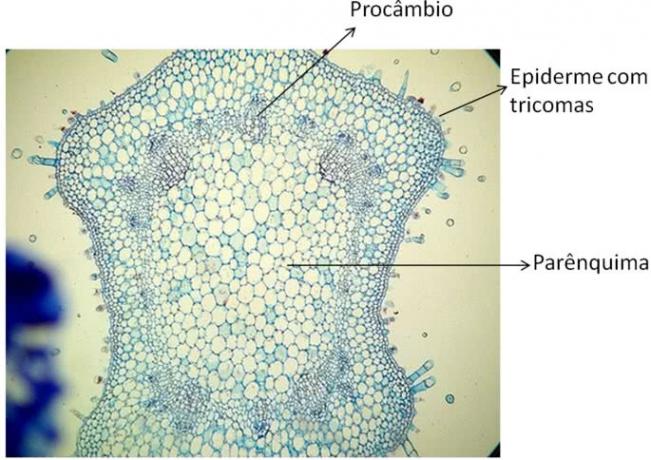O epithelial tissue it is formed by juxtaposed cells, that is, cells that are intimately joined to each other through intercellular junctions or integral membrane proteins.
Epithelial Tissue Functions
The main function of epithelial tissue is to line the outer surface of the body, internal body cavities, and organs. It also features a secretory function.
The functions of the epithelial tissue are:
- Protection and coating (skin);
- secretion (stomach);
- Secretion and absorption (bowel);
- Waterproofing (urinary bladder).
The close union between its cells makes the epithelial tissue an efficient barrier against the entry of invading agents and the loss of body fluids.
Characteristics of epithelial tissue
- Cells very close together, with little extracellular material between them;
- Cells joined together in a well-organized way;
- It has a nervous supply;
- It has no vessels (avascular);
- High capacity for renewal (mitosis) and regeneration;
- Nutrition and oxygenation by diffusion through the basal lamina.
Types of Epithelial Tissue
According to their role, there are two types of epithelial tissue: lining and glandular. However, there may be cells with a secretory function in the lining epithelium.

lining epithelial tissue
Epithelia are made up of one or more layers of cells of different shapes, with little or no interstitial fluid (substance between cells) and vessels between them.
However, the entire epithelium is located on a glycoprotein mesh called basal lamina, which has the function of promoting the exchange of nutrients between the epithelial tissue and the connective tissue adjacent.
According to cell layers, the epithelia can be classified into:
- simple epithelium: are formed by a single layer of cells;
- Stratified Epithelium: have more than one layer of cells;
- Pseudo-stratified epithelium: are formed by a single layer of cells, but have cells with different heights, giving the impression of being stratified.
The epithelial tissue of human skin presents very united cells, this being a stratified epithelium.
This is because the skin's function is to prevent the entry of foreign bodies into the body, acting as a kind of protective barrier, in addition to protecting against friction, sunlight and chemicals.
The epithelial tissue covering the organs is simple, as the fabric cannot be so thick due to the need to change substances.
The epithelia are also classified according to cell shape:
- Pavement Epithelium: has flat cells;
- cubic epithelium: the cells are cube-shaped;
- Prismatic Epithelium: cells are elongated, column-shaped;
- transitional epithelium: the original shape of the cells is cubic, but they are flattened due to the stretch caused by the dilation of the organ.
glandular epithelial tissue
Glandular epithelial tissue cells have the same characteristics as the lining epithelium, however, unlike them, they are rarely found in layers.
Therefore, their cells are very close-knit and usually arranged in a single layer.
Glandular epithelia are tissues with secretory function, which constitute specialized bodies called glands.

Secretory epithelial cells are capable of synthesizing molecules from smaller precursor molecules or modifying them.
Secretory cells can also be isolated between cells of the lining epithelium, or forming such epithelium. For example, coating the cavity of the stomach or part of the respiratory tract.
Read too:
- Digestive system
- Respiratory system
Glands and granular epithelial tissue
most glands of the human body are formed from the glandular epithelium. They can be of two types: exocrine or endocrine.
In the endocrine glands the connection with the lining epithelium no longer exists, the cells reorganize into follicles (thyroid) or cords (adrenal, parathyroid, islets of Langerhans).
At exocrine glands they are made up of two parts: a secretory part (formed by the secretory cells) and an excretory duct (composed of lining epithelial cells).
The duct releases secretions into internal cavities (salivary glands) or to the outside of the body (sweat glands and sebaceous).
See too:
- Integumentary System
- Human Body Tissues
- Muscle tissue
- nerve tissue
- Histology
- Animal Histology



